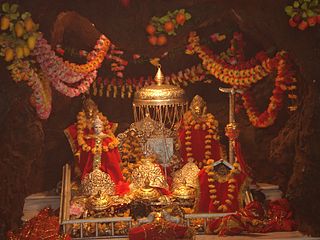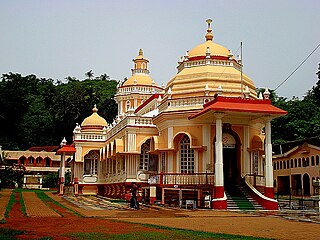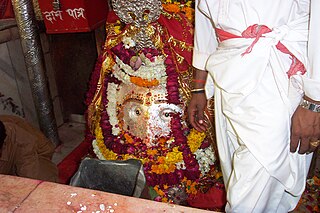Vishwakarma caste
Vishwakarma Caste (also known as Vishwabrahmin / Dhiman Brahmins / Brahmins) describes a Brahmin Caste of India who claim to be descendants of Lord Vishwakarma. They are a caste of engineers, architects, sculptors, temple builders and artists. The term is applied to five sub-castes; blacksmiths, carpenters, coppersmiths, goldsmiths and sculptors.
The contribution of the Vishwakarmis to Hindu art and architecture is immense. The University of Nalanda has been an architectural marvel for ages together as also the iron pillars of Delhi. At the same time Hindu architecture as well as Buddhist architecture represents great contributions of the Vishwakarmis.
Tradition says that the Vishwakarmi castes are subdivided according to the names of their sons. The sons of Lord Vishwakarma were Manu, Maya, Thwastha, Silpi and Vishvajnya. People belonging to the Manu cast are blacksmiths; those of the Manu group are carpenters. The metal craftsmen are known as Thwastha and those who are goldsmiths are called by the name Vishyajnya.
The Vishwakarmi castes have been subdivided into five gotras each corresponding to the name of a Rishi which has been mentioned in the Yajur Veda. The five gotras of the Vishwakarmi are Sanagasya Manu, Sanatanasya Maya, Abhuvanasya Tvashta, Pratanansya SiIpi and Suparnasya Vishvajna. The five gotras of the Vishwakarmis are again subdivided into 25 sub-clans.

Vaishno Devi is a manifestation of the Hindu Mother Goddess, Devi. The words "Maa" and "Mata" are commonly used in India for mother, and thus are often heavily used in connection with Vaishno Devi. Vaishnavi was formed from the combined energies of Kali, Lakshmi, and Saraswati.

Saundatti also known as Savadatti is one of the oldest towns in Belgaum district in the Indian state of Karnataka. It is a celebrated pilgrimage centre located 78 kilometres from Belgaum and 37 kilometres from Dharwad. Savadatti is also the name of the taluk (sub-district), which was previously named Parasgad. There are several ancient temples in Saudatti.

Nimishamba is the name of a temple on the banks of the Cauvery river, located about 2 km from Srirangapattana on the road leading to Sangam (confluence) in the south Indian state of Karnataka.

Kula-dèvatā (transl. clan-deity), also known as Kuladeva or Kuladevi is an ancestral tutelary deity in Hinduism, who is often the object of one's devotion (bhakti), and as a watch over the ancestral family (kula) and children from misfortune. This is distinct from Ishta-devata and village deities.

Umananda Devaloi is a Shiva temple located at the Umananda Island in the middle of river Brahmaputra just opposite the office of the Deputy Commissioner of Kamrup or the Kachari Ghat in Guwahati.
Sharane Sri Danamma Devi was a follower of Jagajyothi Basavanna. Sharane Sri Danamma Devi is worshipped as an incarnation of Goddess Parvati. shri.shiva sharani Danamma Devi originally called as "lingamma" was born to anantaraya and shirasamma in Maharashtra in a small city (grama) of "umarani" in jatta taluk which is 20 miles to the west of bijapur district.Further she was inspired by the Lingayat culture worshipping lord shiva came to Kalyana. Jagajyoti Basavanna forthtold her that you will be worshipped throughout the world by the name "Danamma sharani".From then on lingamma is popularly called and worshipped as Danamma. She started solving the problems of people in kalyana. After the period of Kalyana Kranti she turned to her birthplace to her parents leading her life worshiping "LINGA".She was married to a devotee of shiva called Sangamanatha in sunga which is 12 miles to the north from her village.Both the couples later came to guddapura 8 miles to the west of sunga grama helping people and donating who were needy which means "DAANA", hence her name was "DAANA-AMMA". There is a temple located in guddapura of Shri someshwaranath where danamma used to perform her usual rituals and linga puja. Knowing her importance people of certain community became her followers and trusting her. She is known to make many miracles till today showing her presence those who believe her. She is always been a helping hand to the people who are in difficulty, where there is her name there is no situation of starving or problems she's known to be the incarnation(avatar) of goddess Parvati or adishakti.she always insisted people to follow GURU-LINGA-JANGAMA,and gave lingadiksha to worship lord shiva saying "om namaha shivaya" mantra would lead us to a peaceful life and soul.Each of her miracles are described in 108 namavali by chanting those, we get power,confidence,overcome our problems from devi,adishakti. Thousands of people worship devi by visiting her temple satisfying their wishes, she has been also called as "Varadani Danamma". Later she made a journey towards rameshwara with her husband spreading the vachanas and knowledge of jagajyoti-Basavanna and built he's temple. Along with her husband She came to Kambe city, the second rajadhiraja king of Chola raja's mandalik came to know about her miracles welcomed her and took a lingadiksha from her. Then she came to Kudalsangama where basavanna was "lykya" knowing that her parents were out of this world she turned back to guddapura. One day after performing pooja with pleasure she is known to become Iykya in "LINGA" while distributing the prasad. Her body turned to an Idol,the yadavas vamshas mahadevarajas kingdom, sainatha mandalik is known to have built Danamma Devi temple. Her way of leading life was very clean and pure, same way still now the rituals and Mahapoojas are performed in a pure and clean manner. Every year we can see the fairs (jatras) during "chatti amavasya" and people are resolving all their problems doing sevas. Lot of development is being made for Maha Nirvana. Nirantara Dasoha is also made providing food for people coming from far off-places. God always gives His best to those who leave the choice with him.......

Sri Kalikamba Vinayaka Temple is located in Lower Car Street, Mangalore, India.

The Shree Vajreshwari Yogini Devi Mandir is a Hindu temple dedicated to the goddess Vajreshwari, located in the town Vajreshwari, 75 km away from Mumbai. The town, earlier known as Vadvali, was renamed Vajreshwari in honour of the presiding deity of the temple.

Kalkaji Mandir, also known as Kalkaji Temple, is a Hindu mandir or temple, dedicated to the Hindu Goddess Kali. The temple (mandir) is situated in the southern part of Delhi, in Kalkaji, India, a locality that has derived its name from the temple and is located opposite the Nehru Place business centre and close to the Okhla railway station, Kalkaji Mandir metro station. Hindus believe that the image of the Goddess Kalka here is a self-manifested one, and that the shrine dates back to Satya Yuga when the Goddess Kalika had incarnated and killed the demon Raktabija along with other giant demons.

The Vithoba Temple, officially known as Shri Vitthal-Rukmini Mandir (Marathi: श्री विठ्ठल-रूक्मिणी मंदिर,is a Hindu temple in Pandharpur in the Indian state of Maharashtra. It is the main centre of worship for Vithoba, a form of the god Vishnu or Krishna, and his consort Rakhumai. The temple was built by King Vishnuvardhana of Hoysala Empire between 1108 - 1152 CE upon being convinced by the historical figure Pundalik. Also, there is an inscription in the temple, of a Hoysala King Vira Someshwara dating back to 1237 CE, which grants the temple a village for its upkeep. It is the most visited temple in Maharashtra. The Warkaris start marching from their homes to the temple of Pandharpur in groups called Dindi to reach on Aashadhi Ekadashi and Kartiki Ekadashi. A dip in the holy river Chandrabhaga, on whose banks Pandharpur resides, is believed to have power to wash all sins. All the devotees are allowed to touch the feet of the idol of Vithoba. In May 2014, the temple became the first in India to invite women and people from backward classes as priests.
Mahamaya Kalika Saunsthan is a temple complex in Kansarpal village of Bicholim taluka in the state of Goa, India. The presiding deity of the temple is Kali worshipped in the form of Mahamaya. The goddess Kali, the terrible and cruel to the demons and evil doers, is worshiped with blood sacrifice in most parts of India, in Goa however the fierce invocation of the deity was never popular. As per the regional myths after killing the demons Sumbha and Nisumbha, the deity's anger was soothed and the deity manifested herself in a peaceful (Shanta), gentle (Soumya) form, which is very popular in Goa.
The following temples are in Hyderabad

Shri Shantadurga (Kalangutkarin) Devasthan Nanora is a Hindu temple in Nanoda village in Bicholim taluka in Goa. The presiding deity is Shantadurga worshiped in the form of Vishweshwari; normally Shantadurga is worshipped in a Shanta form, but it is believed that after killing the demons the deity's anger was soothed and the Shanta Soumya form of fierce Durga Devi is worshiped in Goa. Shri Shantadurga is goddess of Wealth; prosperity; light; wisdom; fortune; fertility; generosity; courage; beauty;Divine; grace; charisma and charm.

Hinduism is the largest religion in Kerala and Hindu castes together make up 54.8% of the population of the state according to the 2011 census.

The Taratarini Temple on the Kumari hills at the bank of the River Rushikulya near Brahmapur city in Ganjam District, Odisha, India is worshiped as the Breast Shrine and manifestations of Adi Shakti. The Tara Tarini Shakti Peetha is one of the oldest pilgrimage centers of the Mother Goddess and is one of four major ancient Tantra Peetha and Shakti Peethas in India.

Chamakeri is a village in the Belgaum district of Athani Taluk in the southern Indian state of Karnataka.
The Vishwakarma community, also known as the Vishwabrahmin although having no generally accepted connection to the Brahmins, are a social group of India, sometimes described as a caste. The community comprises five sub-groups—carpenters, blacksmiths, bronze smiths, goldsmiths and stonemasons—who believe that they are descendants of Vishvakarma, a Hindu deity.
Chari is the surname of Vishwakarma community following people:
Sutradhar, also known as Suthar is a Hindu caste within the Vishwakarma community of India. Their traditional occupation is carpentry The great majority of Hindu sutradhars belong to the Vaishnava sect. Vishwakarma is regarded as their patron deity.

The Vaishno Devi Temple is an important Hindu temple dedicated to Vaishno Devi located in Katra at the Trikuta Mountains within the Indian Union territory of Jammu & Kashmir. The temple is one of the 108 Shakti Peethas dedicated to Durga, who is worshipped as Vaishno Devi. It is one of the most visited pilgrimage centers of India. Every year millions of visitors visit the temple. During festivals like Navaratri, the count even increases to one crore visitors. Vaishno Devi Temple is one of the richest temples in India. Authors Michael Barnett and Janice Gross Stein says, "Mata Vaishno Devi Shrine in Jammu has an annual receipts of about $16 million, mainly from offerings by devotees".
















